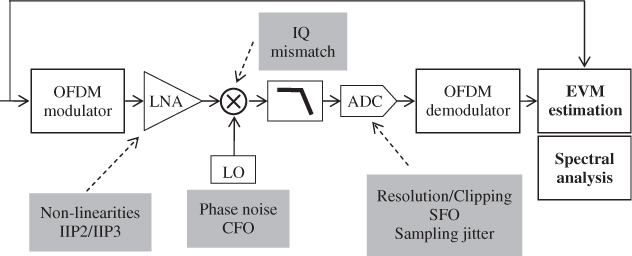3.6 Receiver Impairments Simulation
3.6.1 Introduction
Figure 3.31 presents the configuration of the receiver simulation bench including the following modeled RF analog impairments:
- LNA second- and third-order nonlinearities (IIP2 and IIP3);
- quadrature mixer IQ mismatch (phase and amplitude);
- LO phase noise ;
- CFO;
- SFO;
- sampling jitter;
- ADC clipping and resolution.
Figure 3.31 RX AFE impairments simulation bench

Like the DAC in transmission, the ADC sampling frequency is four times the IFFT/FFT clock, that is, 80 MHz for WiFi and 89.6 MHz for WiMAX.
Compared to the transmitter, we can see that there are more impairments to be taken into account in reception. Indeed, on top of the inherent imperfections of the RF analog front-end, the receiver must also deal with the mismatches between transmission and reception such as CFO and SFO, which are critical factors in the OFDM demodulation performance.
Like we did for the transmission path, we will study each of these impairments separately in order to isolate their impact on the receiver performance.
Regarding the demodulation, perfect OFDM symbol time synchronization is assumed and channel estimation is done using the pilots in order to equalize the FFT output before subcarrier demapping and EVM estimation.
3.6.2 Carrier Frequency Offset
The CFO comes from the difference between the transmitter carrier frequency and the receiver down-conversion ...
Get RF Analog Impairments Modeling for Communication Systems Simulation: Application to OFDM-based Transceivers now with the O’Reilly learning platform.
O’Reilly members experience books, live events, courses curated by job role, and more from O’Reilly and nearly 200 top publishers.

